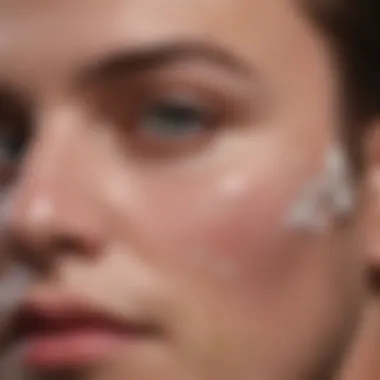Effective Strategies to Eliminate Whiteheads


Intro
Whiteheads are a common skin issue, especially for those with oily or combination skin types. Understanding the factors that contribute to their formation is crucial for effective treatment. In this article, we will examine the causes of whiteheads, explore fundamental skincare practices, and review various treatment methodologies. We will also dispel prevalent myths related to whitehead management and provide practical tips that facilitate clearer skin. This guide aims to empower readers, arming them with essential knowledge to make informed choices regarding skincare products and lifestyle modifications, thus promoting overall skin health.
Understanding Whiteheads
Understanding whiteheads is vital since they are common skin issues that many people face. Learning about whiteheads helps in pinpointing their causes and finding effective solutions. Whiteheads occur when pores become clogged with oil, dead skin cells, and bacteria. This leads to a clearer vision of how to adjust skincare practices and routine for prevention. Moreover, recognizing the triggers is key for maintaining healthy skin.
What Are Whiteheads?
Whiteheads are a type of acne that presents as small, white bumps on the skin's surface. They form when hair follicles become clogged. This usually involves sebum, the oil produced by skin glands. The buildup creates a closed comedo, making it appear white. Unlike blackheads, which are open to the air, whiteheads remain under the skin. Identifying what whiteheads are is essential in managing them effectively.
How Do Whiteheads Form?
Whiteheads form through a process that involves several factors. First, excessive oil production is a prominent trigger. When the skin produces too much sebum, it mixes with dead skin cells. These mixtures can accumulate in hair follicles, leading to blockage. Once the follicle is clogged, bacteria thrive in this environment, resulting in inflammation. This inflammation can manifest as whiteheads.
Why Do Some People Get Whiteheads?
The reason why some individuals are more prone to whiteheads than others can be traced to a combination of genetics, hormonal fluctuations, and environmental factors. Hormonal changes, such as those that occur during puberty or menstruation, can increase oil production, leading to more frequent breakouts. Additionally, some people have skin that is naturally oilier. Environmental conditions, such as humidity and pollution, can also contribute to the formation of whiteheads. Understanding these factors provides insight into why whiteheads may persist despite best efforts to eliminate them.
Identifying Triggers
Identifying the triggers that contribute to the formation of whiteheads is a critical step in managing and preventing them. Understanding these triggers can help tailor a skincare routine to one's specific needs. Knowledge of factors such as hormonal fluctuations, dietary habits, and environmental influences enables individuals to make informed decisions. This targeted approach often leads to more effective skin care practices and improved results.
Hormonal Influence
Hormones significantly impact skin health. An increase in androgens, common during puberty, menstruation, or hormonal therapies, can result in excess oil production. This oil, combined with dead skin cells, forms whiteheads. Women often experience breakouts related to their menstrual cycle due to hormonal shifts.
To mitigate this influence, tracking hormonal patterns can be beneficial. Knowing when hormonal changes occur allows for proactive skin care, such as increasing moisturizing or using specific treatments during these times. Some products with ingredients like salicylic acid can be helpful as they work to unclog pores and reduce inflammation.
Dietary Factors
Diet plays a vital role in skin health. Certain foods can exacerbate the formation of whiteheads. Diets high in sugar and dairy are often linked to increased skin issues. This is attributed to the way these foods can affect insulin and hormone levels.
In contrast, a balanced diet rich in fruits, vegetables, and whole grains can support better skin health. Incorporating foods with Omega-3 fatty acids, such as salmon and walnuts, may also provide benefits by reducing inflammation. Staying hydrated is equally crucial; drinking enough water supports overall skin function and helps to flush out toxins.
Environmental Contributors
The environment can also impact skin condition. Pollution, humidity, and sun exposure influence the occurrence of whiteheads. Pollutants in the air can lead to clogged pores, while high humidity can increase oil production. Individuals living in urban environments may notice a higher incidence of skin issues due to these factors.
Seasonal changes require adjustments in skincare routines. For example, heavier creams may be necessary in winter, while lighter formulations may suffice in summer. Always consider the environmental conditions one is exposed to when selecting skincare products.
"Awareness of external factors can create a more proactive approach in skincare management."
Understanding these triggers—hormonal changes, dietary choices, and environmental impacts—provides a foundation for developing a targeted strategy against whiteheads. Adjusting habits and routines based on these insights can lead to clearer skin and contribute to a healthier overall complexion.
Skincare Routine Essentials
Having a proper skincare routine is crucial in the effort to eliminate whiteheads. This section will discuss key elements that contribute to maintaining clear skin. A consistent routine helps to manage oil production, prevent clogged pores, and enhance overall skin health. Understanding how to tailor your regimen can significantly influence the outcome.
Cleansing Techniques
Cleansing is the foundational step in any skincare routine. It helps remove dirt, oil, and impurities from the skin's surface. For individuals prone to whiteheads, using a gentle, non-comedogenic cleanser is essential.
Look for products containing salicylic acid or glycolic acid, as these ingredients can penetrate pores. Cleansing should be done twice daily, in the morning and evening, to effectively control excess oil.
- Use lukewarm water to avoid stripping natural oils.
- Massage the cleanser gently for about 30 seconds before rinsing.
- Avoid harsh scrubs that can irritate the skin.
Regular cleansing plays a critical role in preventing whitehead formation by keeping the pores clear.


Exfoliation Practices
Exfoliation is a vital step that often gets overlooked. Removing dead skin cells can prevent the skin from becoming clogged. It is typically recommended to exfoliate about two to three times a week.
Chemical exfoliants like alpha and beta hydroxy acids are preferred over physical exfoliants for sensitive skin. Gently incorporating these into your routine can improve skin texture and brightness.
- Physical Exfoliation: Use soft scrub agents if opting for physical methods; however, be cautious to avoid excessive pressure.
- Chemical Exfoliation: Start with lower concentrations to gauge skin sensitivity.
Moisturizing Rules
Moisturizing is often misunderstood. Many individuals with oily skin may think they do not need moisturizer. However, using a lightweight, oil-free moisturizer can help maintain hydration without clogging pores.
Moisturizers containing hyaluronic acid are particularly beneficial, as they retain moisture without adding oiliness to the skin. Applying moisturizer after cleansing and exfoliating locks in hydration.
- Apply moisturizer while the skin is still slightly damp to enhance absorption.
- Avoid heavy creams that may contribute to pore blockage.
Treatment Options for Whiteheads
Understanding treatment options for whiteheads is essential for anyone seeking clear skin. Whiteheads can be stubborn and may require a multifaceted approach to eliminate them effectively. Below, we explore various treatment modalities, ranging from over-the-counter solutions to prescription medications and professional treatments. Knowing the right options and the benefits they offer can help in selecting the most appropriate method for your skin type.
Over-the-Counter Treatments
Over-the-counter treatments are often the first line of defense for whiteheads. These products are accessible without a prescription and are specifically formulated to target acne. Key ingredients to look for include:
- Benzoyl Peroxide: This component kills acne-causing bacteria and aids in exfoliating dead skin cells. It helps to prevent clogged pores, making it effective against whiteheads.
- Salicylic Acid: Known for its ability to penetrate pores and dilute oils, salicylic acid promotes skin cell turnover and clears out impurities from the pores.
- Retinoids: Available in various forms, retinoids increase skin cell production and can help in preventing the formation of whiteheads. They may cause initial dryness but are highly effective in the long run.
Regular usage of these treatments can lead to noticeable improvement over time.
When choosing these products, consider the potency and your skin type. Start with lower concentrations to gauge your skin's reaction before escalating to stronger formulas.
Prescription Medications
For those facing persistent whiteheads, prescription medications may be necessary. Consulting with a dermatologist is advisable for managing more severe cases of acne. Common prescription options include:
- Topical retinoids like Tretinoin or Adapalene: These stronger forms of retinoids can accelerate skin turnover and help unclog pores more efficiently than over-the-counter variations.
- Oral antibiotics, such as Doxycycline or Minocycline: These target bacterial growth internally and can be effective for inflammatory acne that often accompanies whiteheads.
- Hormonal treatments, such as birth control pills: Certain birth control medications can regulate hormonal fluctuations that may contribute to whitehead formation, particularly in women.
Each of these medications may come with side effects. Thus it's vital to discuss options with a healthcare provider to find a suitable plan.
Professional Treatments
If at-home treatments fail to produce desired results, professional interventions are available to tackle whiteheads effectively. Options include:
- Chemical Peels: This treatment involves applying an acid solution to exfoliate the skin deeply, thus removing the outer layer and diminishing whitehead appearance over time.
- Microdermabrasion: This non-invasive procedure mechanically exfoliates the skin, improving texture and tone and helping to prevent future whiteheads.
- Extraction: Conducted by licensed professionals, extraction involves safely removing whiteheads and comedones through a specific technique, which can provide immediate clarity to the skin.
It is important to evaluate the benefits and any associated risks with these treatments. Consultation with a dermatologist can lead to tailored advice based on individual skin conditions and needs.
Natural Remedies and Alternatives
Natural remedies and alternatives present an intriguing route for individuals seeking to manage whiteheads. These strategies often highlight the power of nature and the efficacy of common ingredients found at home. Embracing these methods can lead to a clearer complexion while keeping harsh chemicals at bay. Moreover, some individuals may find that incorporating natural options offers a gentler, yet effective, way to maintain their skin health.
Essential Oils
Essential oils have gained popularity for their diverse benefits in skincare. Oils such as tea tree and lavender possess antibacterial properties, which can combat the bacteria contributing to whitehead formation. Additionally, these oils may help in reducing inflammation and soothing irritated skin. It is important to dilute essential oils with a carrier oil, such as jojoba or coconut oil, before applying them to the skin. This step minimizes the risk of irritation. Regular application, albeit in moderation, can aid in keeping whiteheads under control.
"Using nature’s gifts wisely can yield substantial results without overwhelming the skin."
Home-made Masks
Home-made masks offer personalized solutions for tackling whiteheads. Ingredients like honey, yogurt, and oatmeal can create masks that cleanse pores and nourish the skin. For instance, a simple honey and cinnamon mask can deliver antibacterial properties while moisturizing the skin. Another option is an oatmeal mask, which can absorb excess oil and exfoliate the skin gently. The beauty of these home-made masks lies in their affordability and accessibility. Using them once or twice a week can yield noticeable improvements in skin texture and clarity.


Dietary Supplements
In addition to topical treatments, dietary supplements can play a valuable role in the fight against whiteheads. Nutrients like zinc and omega-3 fatty acids are known for their skin benefits. Zinc helps in regulating oil production, while omega-3 fatty acids contribute to skin hydration and reduce inflammation. Including these supplements in a daily routine may enhance overall skin health. However, it is advisable to consult with a healthcare professional before starting any supplement regimen to ensure compatibility with individual health conditions.
Natural remedies and alternatives can complement traditional skincare efforts. By understanding how to incorporate these methods effectively, one can take proactive steps toward achieving clearer skin. The focus should remain on finding what works best for each individual, recognizing that skincare is inherently personal.
Preventative Measures
Preventative measures play a crucial role in managing whiteheads effectively. Taking proactive steps can drastically reduce their formation and lead to healthier skin overall. By understanding specific elements, benefits, and considerations regarding these measures, individuals can equip themselves with the knowledge necessary to maintain clear skin and mitigate potential issues associated with whiteheads.
Daily Habits to Adopt
Establishing beneficial daily habits is fundamental in preventing whiteheads. These habits not only contribute to skin health but also promote a overall sense of well-being. Key habits include:
- Consistent Cleansing: Clean your face twice a day using a gentle cleanser. This helps to remove excess oil and dirt buildup.
- Avoid Touching Your Face: The skin on the face is sensitive. Frequent touching can transfer bacteria and oils from the hands, leading to breakouts.
- Change Pillowcases Regularly: Dirty pillowcases can harbor bacteria. Aim to wash your pillowcases at least once a week.
Choosing the Right Products
Selecting appropriate skincare products is essential in preventing whiteheads. Not all products suit every skin type. Pay attention to the following when choosing your skincare items:
- Non-Comedogenic Products: Look for products labelled as non-comedogenic. These are less likely to clog pores.
- Avoid Heavy Oils: Opt for lighter oils or oil-free moisturizers to reduce the risk of clogging pores.
- Ingredients to Seek: Salicylic acid and benzoyl peroxide can help clear and prevent whiteheads. Incorporating these into your routine can be beneficial.
Understanding Skin Types
Each skin type has unique characteristics. Understanding your skin type is vital for effective prevention of whiteheads. Skin types can include:
- Oily Skin: More prone to acne and whiteheads. Regular exfoliation and oil control products are needed.
- Dry Skin: This skin type may still experience whiteheads; hydrating products that do not block pores are recommended.
- Combination Skin: A mix of oily and dry areas. Tailored products that cater to both types can be effective.
"Knowing your skin type can guide you to the right skincare solutions, significantly reducing the occurrence of whiteheads."
In summary, implementing preventative measures such as cultivating daily habits, choosing the right products, and understanding your skin type are crucial strategies. These practices not only help in managing whiteheads but also contribute to a comprehensive skincare regime. Regularly reassessing your habits and making necessary adjustments will support your efforts in maintaining clear and healthy skin.
Common Myths
Understanding the myths surrounding whiteheads is crucial in the journey to effective skin care. Misinformation can lead to poor choices in treatment and maintenance routines, potentially worsening the situation. By debunking these myths, individuals can make informed decisions that promote clear skin and overall skin health.
Myth: Picking at Whiteheads Helps
One of the most commonly believed myths is that picking at whiteheads will lead to quicker removal. Many individuals assume that squeezing or picking will hasten the process, believing that it can detoxify the skin. However, this misconception is misleading and counterproductive.
When whiteheads are picked, several negative outcomes can occur:
- Skin Damage: The skin can become irritated and inflamed, leading to redness and potential scarring.
- Infection Risk: Introducing bacteria through open skin can cause infections that worsen the condition, leading to more severe acne.
- Delayed Healing: Rather than accelerating the elimination of whiteheads, picking often prolongs the healing process, making it more difficult to achieve clear skin.
Instead of picking, it is advisable to follow a consistent skincare routine that focuses on proper cleansing and treatment. This approach minimizes the chances of new whiteheads forming while allowing existing ones to heal naturally.
Myth: All Skincare Products Are Beneficial
Another prevalent myth is that all skincare products are beneficial for everyone with whiteheads. The assumption is that any topical formulation will contribute positively to skin health. This myth can lead to confusion and adverse effects, particularly for individuals who have sensitive or acne-prone skin.
In fact, the effectiveness of a skincare product heavily depends on several factors, including:
- Skin Type: Oily, dry, and combination skin require different ingredients for optimal care. A product that works well for one skin type might trigger breakouts in another.
- Ingredient Composition: Many products contain comedogenic ingredients that can clog pores. It is essential to select non-comedogenic formulations to prevent additional whitehead formation.
- pH Balance: The skin’s natural pH should be considered when selecting products. A product that disrupts the skin's pH balance can lead to further complications, including increased oil production.
Awareness and education regarding specific skin needs are necessary for selecting effective products. Optimal skincare should not be about following trends or popularity but rather understanding one's unique skin concerns.
Always consult with a dermatologist to determine the best products for your skin type, as this can significantly improve your skincare routine and reduce whiteheads.
Lifestyle Adjustments


Lifestyle adjustments play a crucial role in managing and eliminating whiteheads. While topical treatments and skincare routines are vital, addressing underlying lifestyle factors can enhance overall skin health. These adjustments can help maintain the skin's balance and prevent future breakouts, especially for those who struggle with acne.
Incorporating effective lifestyle changes focuses on two primary areas: stress management and hydration. Both areas significantly influence skin condition and overall well-being.
Stress Management Techniques
Managing stress is essential for skin health. High stress levels can lead to hormonal fluctuations, which in turn may trigger the production of excess oil. This oil can clog pores, leading to whiteheads and other forms of acne. To mitigate stress, consider techniques such as mindfulness meditation or yoga. These practices promote relaxation and enhance emotional resilience.
Here are some effective stress management techniques:
- Mindfulness Meditation: Dedicate time each day to practice mindfulness. Focus on your breath and allow thoughts to pass without judgment. This can help clear mental clutter and reduce anxiety.
- Regular Exercise: Engaging in physical activity releases endorphins, which contribute to improved mood. This can be as simple as a daily walk or as structured as a fitness class.
- Adequate Sleep: Prioritize sleep to help your body recover from daily stressors. Lack of sleep can exacerbate stress and negatively impact skin condition. Aim for 7-9 hours of quality rest each night.
"Mental health is just as important as physical health for achieving clear skin. Managing stress can lead to a significant decrease in breakouts.”
Hydration Importance
Hydration is another critical aspect of skin health that is often overlooked. Drinking sufficient water can help maintain skin elasticity and prevent dryness. Well-hydrated skin is more resilient to external factors that may lead to breakouts.
Consider these hydration tips:
- Drink Enough Water: Aim for at least 8 cups of water daily. Adjust this based on your activity level and climate.
- Consume Water-Rich Foods: Incorporate fruits and vegetables high in water content, such as cucumbers, watermelon, and oranges, into your diet.
- Limit Diuretics: Reduce intake of caffeinated and alcoholic beverages, which can dehydrate the body.
A consistent approach to both stress management and hydration can help create a basis for clear skin. These lifestyle adjustments are not just recommendations; they are essential components of an effective strategy to combat whiteheads. By addressing these areas, individuals can pave the way for healthier skin and overall well-being.
When to Seek Professional Help
Recognizing when to seek professional help for whiteheads is crucial for maintaining skin health. While many individuals manage whiteheads with at-home treatments, there are instances where professional intervention becomes necessary. Consulting a dermatologist can provide targeted solutions that are often more effective than over-the-counter options. This is particularly true when whiteheads are persistent, causing noticeable distress, or associated with other skin issues such as acne.
Signs You Should Consult a Dermatologist
Several indicators suggest that it may be time to consult with a dermatologist:
- Chronic Whiteheads: If whiteheads recur frequently despite your best efforts to manage them at home, this is a clear sign that underlying issues may be at play.
- Severe Inflammation: Redness and swelling accompanying whiteheads can indicate a more severe skin condition, warranting a professional assessment.
- Pain or Discomfort: If the whiteheads are painful or tender to the touch, these symptoms could signify infection or irritation.
- Scarring: Noticing scars or dark spots after a whitehead has healed suggests that previous treatments were insufficient, and you may benefit from expert guidance.
- Worsening Condition: If your skin's condition worsens, with increased breakouts or the appearance of cystic acne, a dermatologist's insight is crucial.
These signs highlight the importance of proactive skin management. As skin issues can often stem from hormonal, dietary, or lifestyle factors, a dermatologist can help identify these triggers effectively.
Understanding Dermatological Procedures
Dermatologists have a range of procedures and treatments at their disposal for effectively addressing whiteheads and related concerns. Some common procedures include:
- Chemical Peels: These treatments involve the application of acids that exfoliate the skin, promoting cell turnover and unclogging pores. This may significantly reduce the occurrences of whiteheads.
- Extraction: In-office extraction can effectively remove whiteheads and prevent them from worsening. This process is performed under sterile conditions to minimize the risk of complications.
- Prescription Medications: Dermatologists may prescribe topical retinoids or oral medications that help manage underlying causes, providing a long-term solution rather than just temporary relief.
- Laser Treatments: For those with severe skin conditions, laser therapy can help in reducing inflammation, targeting bacteria, and improving skin texture over time.
Professional assistance in skin care is often crucial for successful management, as dermatologists offer personalized solutions tailored to individual needs.
Seeking professional help should not be a last resort but rather a proactive step in achieving healthier skin. Understanding the signs that indicate the need for expert advice can lead to significant improvements.
Closure
In this article, we examined the intricacies surrounding whiteheads and their effective elimination through various targeted strategies. The relevance of addressing whiteheads cannot be overstressed. These skin blemishes not only impact one’s appearance but can also affect self-esteem and confidence. Understanding the root causes, such as hormonal changes and environmental factors, lays the groundwork for effective prevention and treatment.
Summarizing Effective Strategies
To effectively combat whiteheads, one must adopt a multi-faceted approach. Here are key takeaways:
- Consistent Skincare Routine: Establish a daily regimen that includes cleansing, exfoliating, and moisturizing tailored to your skin type. Using products that incorporate ingredients like salicylic acid or benzoyl peroxide can help keep pores clear.
- Diet and Lifestyle: A balanced diet rich in antioxidants not only supports overall health but can also enhance skin clarity. Reducing processed sugar and dairy intake may mitigate breakouts associated with whiteheads.
- Stress Management: Elevated stress levels lead to hormonal imbalances that can exacerbate skin issues. Techniques such as meditation or physical exercise can help manage stress effectively, thus promoting clearer skin.
It's also crucial to dispel myths surrounding whitehead treatment, such as the belief that picking can aid in healing. Instead, adopting professional treatment when needed can lead to better outcomes and prevent further irritation or scarring.
Long-term Skin Care Approach
Long-term maintenance of clear skin requires commitment. This includes periodic consultation with dermatologists who can provide tailored advice based on your skin's unique needs. Regularly adjusting your skincare routine according to seasonal changes and personal skin responses can ensure sustained skin health.
In addition, being mindful of the products you choose plays a significant role. Opt for non-comedogenic products to avoid pore blockage, ensuring they align with your individual skin type and issues.
To summarize, a dedicated and informed approach to skincare will lead to effective elimination of whiteheads while promoting long-lasting skin health. For men who value style and appearance, investing time and resources into proper skin care is an essential part of grooming and personal presentation.















